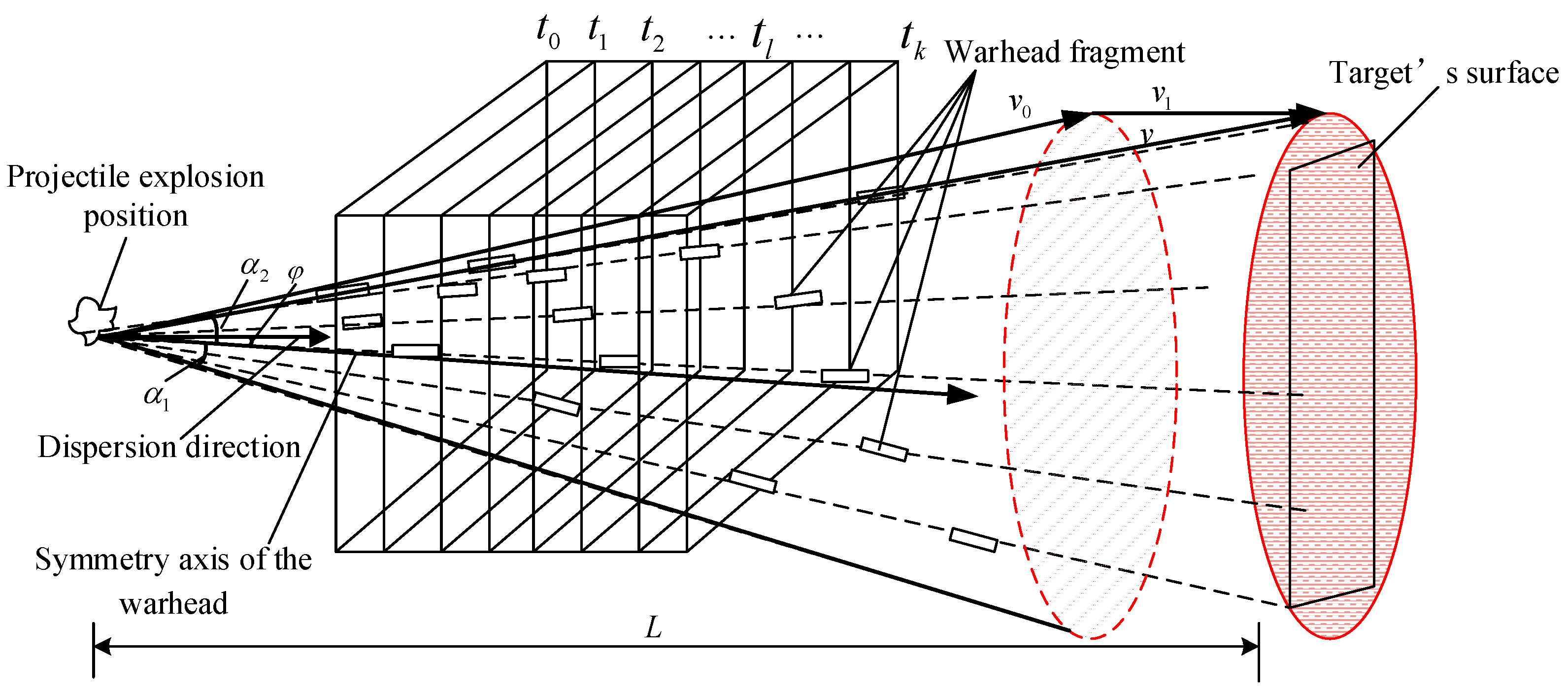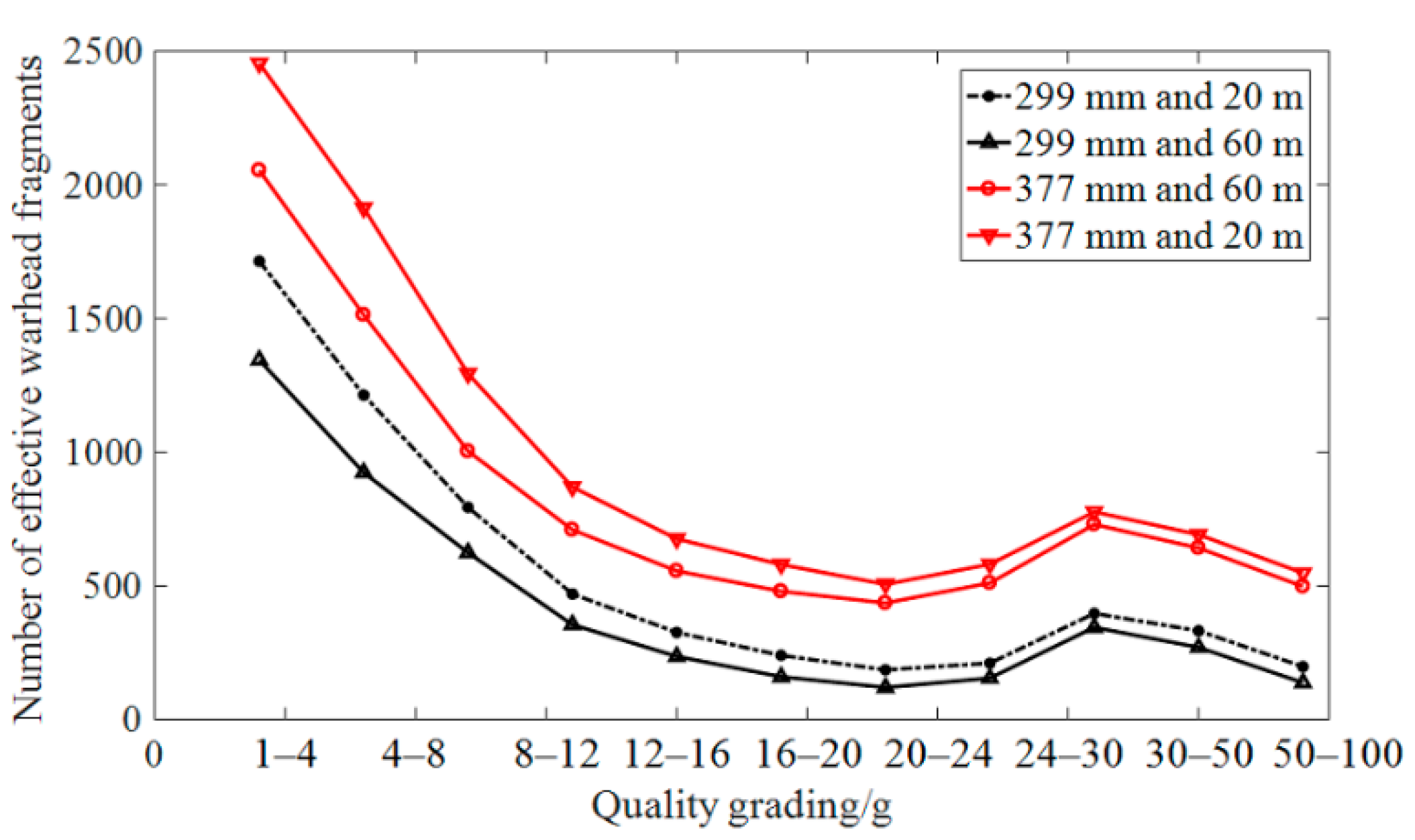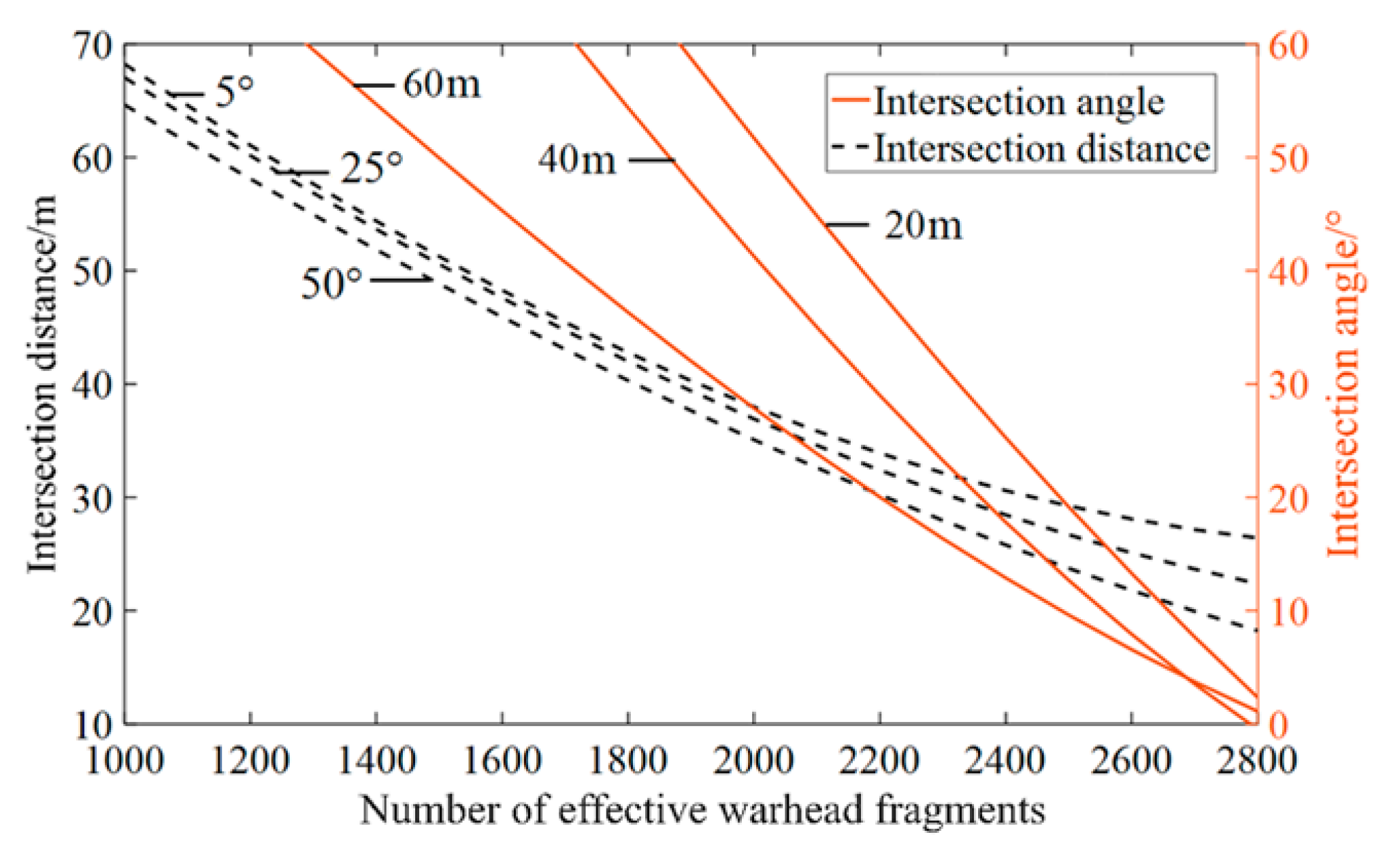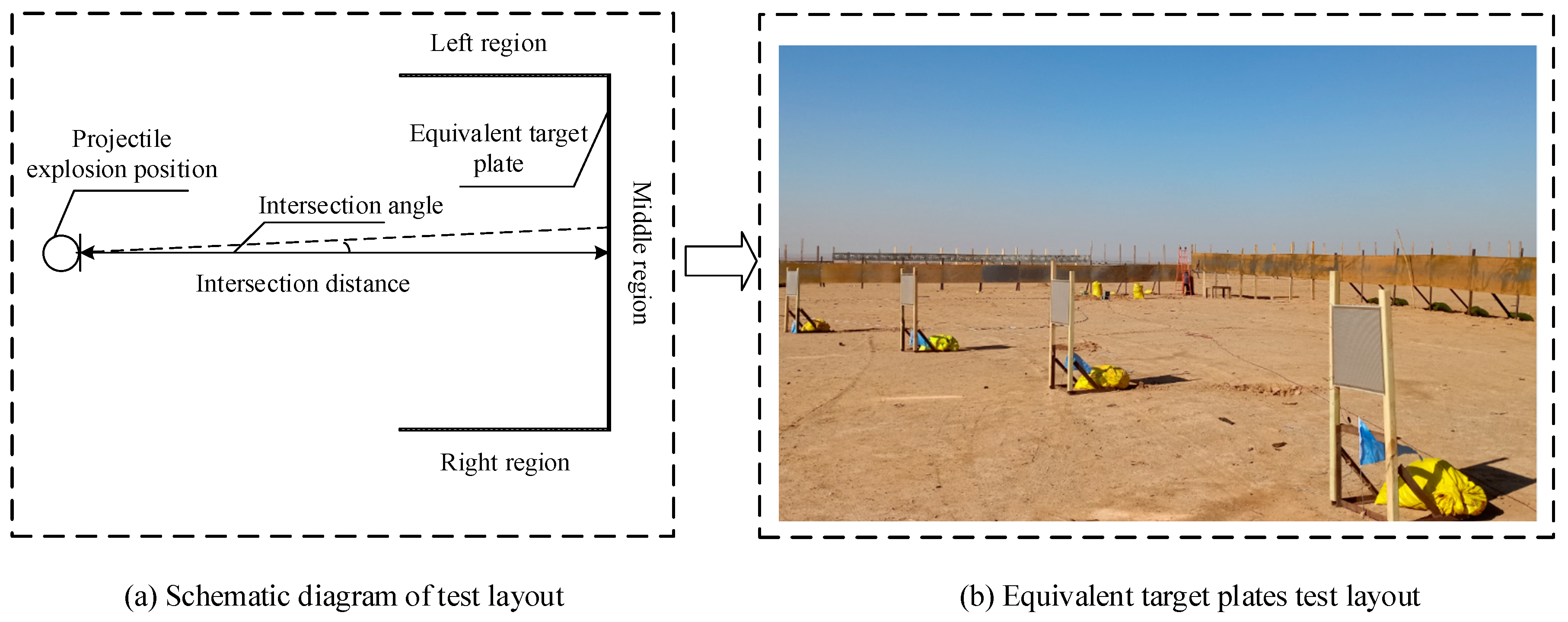3.1. Simulation Analysis
Assuming that the warhead adopts the same shell material and equivalent explosive charge, the dispersion ranges
ω1 and
ω2 of the warhead fragments are (20°, 60°) and (60°, 120°), respectively. The dynamic dispersion density distribution of the warhead fragments in the warhead fragment field formed by the explosion of a large-diameter warhead is given in combination with (3), and its trend is shown in
Figure 2.
For the same type of projectile, it is considered that the total number of warhead fragments formed by the warhead explosion is unchanged. When the intersection distance of projectile and target is determined, the action radius of the warhead fragment field becomes larger, and the warhead fragment dispersion density decreases with the increase in the warhead fragment dispersion angle. If the intersection distance of projectile and target is large, the warhead fragment dispersion density decreases in the area of the warhead fragments hitting the target. Moreover, considering the intersection angle of the projectile and target, the number of effective warhead fragments hitting and penetrating the target is affected to a certain extent, which impacts the target damage probability.
Assuming that the damaged target has been given, the target damage effect is calculated and analyzed by using two types of warheads. These two types adopt the same shell material and equivalent explosive charge. The diameters of the two projectiles are 299 mm and 377 mm. The two warheads explode at the intersection distance of 20 m and 60 m. The variable interval quality classification method is used to divide the quality of the warhead fragments into several quality intervals. In the interval with a large number of warhead fragments, more quality intervals should be divided. On the contrary, the quality intervals should be divided less. The warhead fragment quality of the warhead is divided into nine levels. The warhead fragment quality distribution of the two types of warheads and the quantity distribution of the effective warhead fragments hitting the target are shown in
Figure 3.
Figure 3 shows that the projectiles with diameters of 299 mm and 377 mm follow the same mass classification law, and the larger the diameter of the projectile, the more effective the warhead fragments under the same mass classification condition. For the same type of warhead, when the intersection distance of projectile and target is 20 m, the number of effective warhead fragments under the same quality classification is greater than that when the intersection distance of projectile and target is 60 m. The main reason for this behavior is the attenuation of flight velocity of the warhead fragment with the increase in the intersection distance. Combined with the law of minimum kinetic energy of warhead fragments penetrating the target, the minimum mass of effective warhead fragments increases with the increase in intersection distance. This phenomenon reduces the number of effective warhead fragments meeting the minimum mass requirement under the same mass classification.
Based on the same type of warhead, the variation in the number of warhead fragments hitting the target under different intersection angles and intersection distances calculated according to (9) are shown in
Figure 4.
The figure shows that the number of effective warhead fragments decreases with the increase in the intersection distance. For a given intersection distance, the number of warhead fragments hitting the target in the warhead fragment field reduces with an increase in the intersection angle. The probability of the warhead fragment penetrating the target is not only affected by the warhead fragment’s own ability (velocity and quality) but also by the intersection distance. If the intersection distance is large, the velocity of the warhead fragments formed by the same type of warhead explosion hitting the target decreases, reducing the number of effective warhead fragments penetrating the target. This reduces the damaged area of the target and directly affects the damage effectiveness of the warhead fragments against the target. Therefore, the vulnerable characteristics of the target area should be considered for accurate evaluation of the target damage probability of warhead fragments in the warhead fragment field formed by the warhead explosion.
Assuming that the target is stationary, the target area is divided into three vulnerable areas: the front, left, and right of the target, denoted as A1, A2, and A3, respectively. The warhead is placed in the three areas of the target at a certain distance; the explosion height of the warhead is 1.5 m.
Figure 5 shows the change curve of the target damage probability at different intersection distances.
Figure 5 shows that when the warhead is placed in the front area of the target, the target damage probability is the largest. When the warhead is placed in the left and right areas of the target, the target is the least vulnerable to damage, and the target damage probability is the lowest. The target damage probability varies with the intersection distance of projectile and target. The larger the intersection distance, the smaller the target damage probability. At the same time, the target damage probability formed by the warhead with a diameter of 377 mm after the warhead explosion is higher than that of the warhead with a diameter of 299 mm.
Due to the influence of warhead explosion height and flight velocity on the target damage probability, assuming a stationary target, the target damage probabilities under different conditions, such as warhead explosion heights of 1 m, 2 m, 3 m, and 4 m and warhead flight velocities of 200 m/s, 300 m/s, 400 m/s, and 500 m/s, are calculated and shown in
Figure 6.
It can be observed from
Figure 6 that when the warhead explosion height is the same, the target damage probability increases nonlinearly with the flight velocity of the warhead. The higher the flight velocity of the warhead, the greater the target damage probability. When the flight velocity of the warhead is the same, the target damage probability decreases nonlinearly with the increase in the warhead explosion height. The higher the warhead explosion height, the smaller the target damage probability. The reason is that the flight velocity of the warhead affects the initial velocity of warhead fragments. For a given intersection distance, the higher the flight velocity of the warhead, the greater the initial velocity of warhead fragments and the higher the number of warhead fragments penetrating the target. The explosion height of the warhead determines the intersection angle. For a given intersection distance, the smaller the warhead explosion height; i.e., the smaller the intersection angle, the lower the number of warhead fragments that fail to hit the target. The effectiveness of the warhead fragment hitting the target needs to be further determined according to its quality and velocity. It can be noted that the warhead’s explosion height and flight velocity affect the damage caused by the warhead to the target.
3.2. Experimental Analysis
Due to the limited actual test conditions, all warheads used to damage the simulated target by the static explosion are of identical types. The damaging effect of the warhead fragments in the warhead fragment field after the warhead explosion is analyzed. In the static explosion test, a few equivalent targets with rectangular steel plates are used to simulate the damaged target and are arranged in a U shape. The test layout scene is shown in
Figure 7a. The equivalent target plate in the center of the U-shaped region simulates the central area of the target, which is called the middle region. The equivalent target plates arranged on both sides of the U-shaped region are the other areas of the target, which are the left and right regions. In the test, the equivalent target plate is arranged first, and subsequently, the projectile is placed at a certain distance from the center of the middle area. Before the projectile explodes, the vertical distance between the projectile and the middle area of equivalent target plate is measured. Subsequently, the intersection angle between the warhead and the middle area is calculated, which is the intersection angle between the projectile and the target.
Figure 7b shows the layout of the equivalent target plate prior to the warhead explosion.
In the test, the size of the selected equivalent target plate is the same; the length and width are 2 m and 1 m, respectively; and the thickness is about 10 mm. The target plate is fixed on a woodpile, and its plane is perpendicular to the ground. The same type of warhead is used to carry out the test under the conditions of different intersection distances and different intersection angles. The single-point marker is pasted at the corner of each equivalent target plate prior to the warhead explosion. The single-point marker is made up of flat top glass beads, and its surface should be free from dust and should not be affected in rain. Based on the size range of the equivalent target plate in the actual test, the model of the industrial photography camera is chosen as D750. Its resolution ratio is 6016 × 4016 pixels, the number of effective pixels is equal to 24.32 million pixels, the size of the sensor is 35.9 mm × 24 mm, and the focal length of lens is 24 mm. When a single equivalent target is photographed at a close range, the image of the equivalent target can reach a resolution of about 1 mm to minimize the error of area measurement.
The industrial photography camera is equipped with a flash lamp. The macro photography ring flash lamp is installed in front of the lens of the camera to ensure that the flash-light axis is coaxial with the photography light axis, which reduces the deviation angle of the light source. The flash lamp is configured when the industrial photography camera takes pictures, which is used to improve the brightness of the single-point marker in the sequence images of equivalent target plates. This improves the contrast between the target and the background when the industrial photography camera takes photos. After the warhead explosion, the industrial camera is used to take photos of each equivalent target plate damaged by warhead fragments in order to obtain the damage information. All the photos of the equivalent target plate are processed in the software of the upper computer, which provides the number and damage area of each equivalent target plate hit by warhead fragments as well as the damage information of each region of the simulated target. All this information provides data that can be used for effectively calculating the target damage probability.
The photographing method is used to calculate the relevant data information in each test. The specific process is as follows: the industrial photography camera is used to acquire the equivalent target plate photo at a close range, requiring only a weak flash to obtain the high brightness image of the single-point marker. Using the fixed shape and area of the single-point marker, the geometric distortion correction of the equivalent target plate is carried out. In addition, the accuracy of the perforation area of the equivalent target plate fragment is verified. The sequence images of equivalent target plates acquired after the explosion are processed in the upper computer software. The processing contents include: geometric distortion correction of a single equivalent target plate, equivalent target plate area segmentation, warhead fragment penetration equivalent target plate region extraction, damage area calculation, etc. After these steps, the front view of the equivalent target plate, the number of warhead fragments hitting each equivalent target plate, and the area of warhead fragments penetrating the equivalent target plate are obtained.
In the first round of the test, the warhead is placed horizontally on the ground at the center of the equivalent target plate in the middle area. The distance and the intersection angle between the warhead and the center of the equivalent target plate in the middle area are about 41.8 m and 2.6°, respectively.
Table 2 shows the test data.
In the second round of the test, the warhead is still placed in the center of the equivalent target plate in the middle area. The distance from the warhead to the center of the equivalent target plate in the middle area is 83.5 m. At this time, the intersection angle between the warhead and the center of the equivalent target plate in the middle area is about 2.4°. The test data are shown in
Table 3, where the unit of the damaged area of the warhead fragments penetrating the target is mm
2.
According to
Table 2 and
Table 3, when the distance between the equivalent target plate and the projectile explosion position is 41.8 m, the probability of intersection between the warhead fragments and the target is calculated as 92.2% using (14). Next, the target damage probability is calculated as 3.69% using (15). When the distance between the equivalent target plate and the projectile explosion position is 83.5 m, the probability of intersection between the warhead fragment and the target and the target damage probability are calculated as 75% and 3.16%, respectively.
It can be found that the number of warhead fragments hitting a single equivalent target plate in the middle area at 41.6 m is significantly higher than that at 83.5 m. Compared with the numbers of warhead fragments on the left and right equivalent target plates at 41.8 m, the numbers of warhead fragments on the left and right equivalent targets at 83.5 m are significantly increased. With the increase in the intersection distance of projectile and target, the kinetic energy when the warhead fragment hits the equivalent target plate attenuates at 83.5 m compared with that when the warhead fragment hits the equivalent target plate at 41.6 m. The probability of the warhead fragment failing to hit and damage the target increases; i.e., the number of warhead fragments that cannot hit the target increases. At the same time, the radius of the warhead fragment field formed by the same type of warhead explosion increases when the intersection distance is 83.5 m. This behavior signifies that the dispersion distribution density of the warhead fragment decreases, reducing the number of warhead fragments hitting the equivalent target plate. Finally, the damage probability of the equivalent target plate at 83.5 m is reduced, verifying the influence of the intersection distance on the target damage probability.
In the third round of the test, the warhead is still placed horizontally on the ground at the center of the equivalent target plate in the middle area. It is about 40.4 m away from the center of the equivalent target plate in the middle area. At this time, the angle between the warhead and the center of the equivalent target plate in the middle area is about 5.9°.
Table 4 shows the test data.
Comparing the test data of
Table 2 and
Table 4, it can be found that when the intersection angle is increased to 5.9°, the number of equivalent target plates arranged on the left-side of the U-shaped area hit by the warhead fragments is higher. On the contrary, the number of equivalent target plates on the right-side area hit by the warhead fragments is significantly reduced. The number of total warhead fragments is reduced in the target, which is mainly related to the intersection angle between the warhead and the equivalent target plate in the middle area. According to (14), the probability of intersection between the warhead fragment and target decreases to 83.1%.
When the intersection distance is relatively close and is about 40 m, the number of effective warhead fragments decreases due to the increase in the intersection angle from 2.6° to 5.9° although the distribution density of warhead fragments changes slightly after the warhead explosion. Therefore, the overall target damage probability is reduced. According to (15), the target damage probability is calculated as 3.41%. The results verify that the intersection angle influences the target damage probability. The analysis of simulation and test results verifies the effects of intersection distance and intersection angle on the target damage probability. Based on the test, the probability of damage to the target caused by the projectile proximity explosion warhead fragments is calculated, and the results are consistent with the established target damage probability calculation model.
In their paper, Li et al. [
11] established a target damage efficiency assessment calculation model according to the damaged area of and the damage characteristics of the target. Si et al. [
19] studied the method of assessing the damage caused by the fragmentation warhead against airplane targets; the function to calculate the number of warhead fragment impacting the targets was provided under the condition of random intersection of missiles and targets, and they deduced the damage probability. This paper establishes the calculation function of the number of effective warhead fragments hitting the target, introduces the profit-loss value of warhead fragment group after the warhead explosion as based on these two factors, and derives the target damage assessment mathematical model under the condition of random intersection of the projectile and the target. Assuming that the intersection angle of the projectile and the target is 2°, the target damage probability under different intersection distances is calculated by using the proposed method in this paper and the methods of references [
11,
19], as shown in
Figure 8.
It can be seen from
Figure 8 that when the intersection angle of the projectile and the target is fixed, the target damage probability decreases with the intersection distance increases; at the same time, with the increase of intersection distance, the change curves of target damage probability calculated by the methods proposed in references [
11,
19] are basically similar; this is because the two methods mainly consider the damage area of warhead fragments to the target and the characteristics of the target itself to establish the target damage assessment mathematical model. However, the change of target damage probability calculated by the method proposed in this paper has some differences from the two methods; the mathematical model established in this paper considers not only these two factors but also the profit-loss value of the warhead fragment group; the capability matrix of the warhead fragment group is constructed according to the quality, quantity, and storage velocity of the warhead fragments, and then, the profit-loss value of the warhead fragment group is established. Because the power situation of dynamic dispersion warhead fragments formed by the warhead explosion is not completely the same, this function can more accurately reflect the power situation of warhead fragment groups, which adds more sufficient factors to the target damage assessment mathematical model. It is helpful to accurately evaluate the target damage probability.














